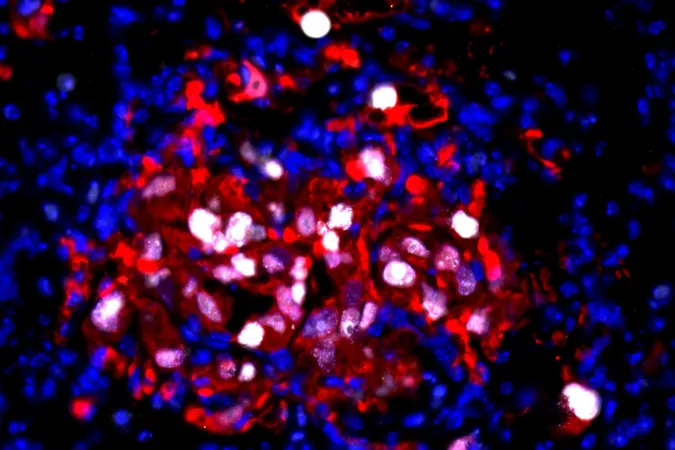
How Inflammation Awakens 'Sleeping' Cancer Cells, Allowing Them to Multiply
2025-09-18
Author: Arjun
The Dormant Danger: Unveiling 'Sleeping' Cancer Cells
Cancer cells are notorious for their singular mission: growth and division. Most of them remain clustered within their original tumor, but some rogue cells manage to break away and travel to distant organs. There, they can lie dormant for years, undetected and inactive, much like hidden landmines waiting to explode.
This process, known as metastasis, is particularly prevalent in breast cancer, where patients can experience a resurgence of the disease long after their initial treatment—sometimes even decades later—manifesting in entirely different organs.
Cracking the Code of Metastasis
Leading the charge to understand this phenomenon is Robert Weinberg, a distinguished professor at MIT and a pioneering figure in cancer research. For decades, he has been dedicated to unraveling the intricacies of metastasis and seeking strategies to enhance survival rates for patients with metastatic breast cancer.
In his latest groundbreaking research, recently published in The Proceedings of the National Academy of Sciences, Weinberg and his team posed a pivotal question: What triggers these dormant cancer cells to awaken and begin their perilous cycle of growth and division again? Their findings point to an unexpected instigator.
The Role of Inflammation in the Awakening Process
The study reveals that the awakening of these dormant cancer cells is not merely a random occurrence; it is catalyzed by inflammation in the surrounding tissue. One contributing factor to this inflammation is bleomycin, a frequently used chemotherapy drug known to cause scarring and thickening of lung tissue.
"The inflammation jolts the dormant cancer cells awake," Weinberg explains. "Once they are awakened, they begin to multiply again, which can lead to the formation of new, life-threatening tumors throughout the body."
Understanding the Journey of Cancer Cells
Metastasis involves a complex journey for cancer cells. First, they must break free from the confines of their original tumor. Typically, cells remain attached to each other via surface proteins that function as molecular 'velcro.' However, certain cancer cells undergo genetic changes that enable them to disrupt this adhesion, making them more mobile and invasive.
Once they detach, these cancer cells can invade blood vessels and lymphatic channels, using them as conduits to distant organs. While many cancer cells meet their demise during this treacherous journey, a select few endure. These resilient cells can exit the bloodstream and infiltrate different tissues—lungs, liver, bone, and even the brain—leading to the emergence of new, often more aggressive tumors.
The Grave Implications of Metastasis
Nearly 90% of cancer-related deaths are attributed not to the original tumor, but to the spread of cancer throughout the body. This stark statistic underscores the critical need to understand how these 'sleeping' cancer cells can reawaken and grow anew.
Once these cells establish themselves in new tissues, they confront a challenging environment—the tumor microenvironment—that may be inhospitable. They face ongoing threats, particularly from the immune system, which seeks to eliminate them. To endure, many of these cancer cells slip into a protective dormancy, halting their growth and division. This dormant state also renders them largely resistant to conventional cancer treatments, which predominantly target actively dividing cells.
A Call to Action in Cancer Research
Understanding the mechanisms behind the awakening of dormant cancer cells and their subsequent proliferation could revolutionize treatment strategies. As researchers like Weinberg delve deeper into this crucial area, hope for improved survival rates for metastatic cancer patients hangs in the balance.



 Brasil (PT)
Brasil (PT)
 Canada (EN)
Canada (EN)
 Chile (ES)
Chile (ES)
 Česko (CS)
Česko (CS)
 대한민국 (KO)
대한민국 (KO)
 España (ES)
España (ES)
 France (FR)
France (FR)
 Hong Kong (EN)
Hong Kong (EN)
 Italia (IT)
Italia (IT)
 日本 (JA)
日本 (JA)
 Magyarország (HU)
Magyarország (HU)
 Norge (NO)
Norge (NO)
 Polska (PL)
Polska (PL)
 Schweiz (DE)
Schweiz (DE)
 Singapore (EN)
Singapore (EN)
 Sverige (SV)
Sverige (SV)
 Suomi (FI)
Suomi (FI)
 Türkiye (TR)
Türkiye (TR)
 الإمارات العربية المتحدة (AR)
الإمارات العربية المتحدة (AR)